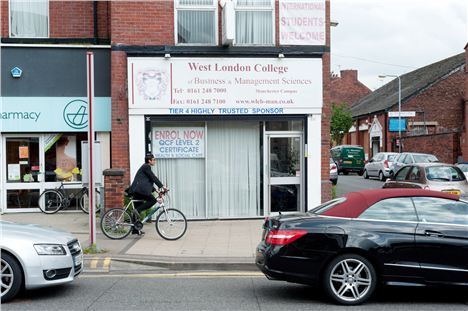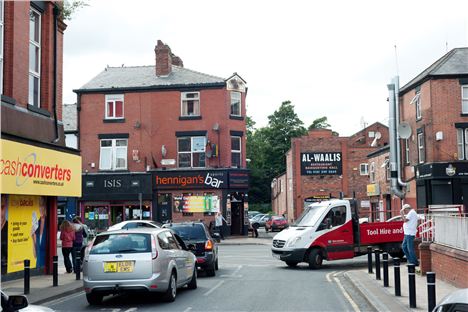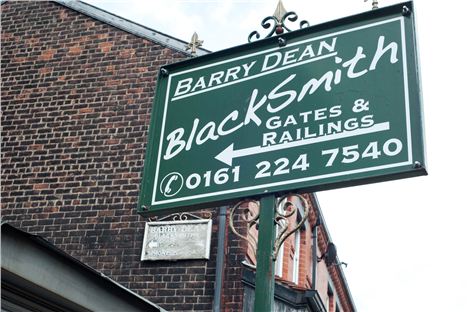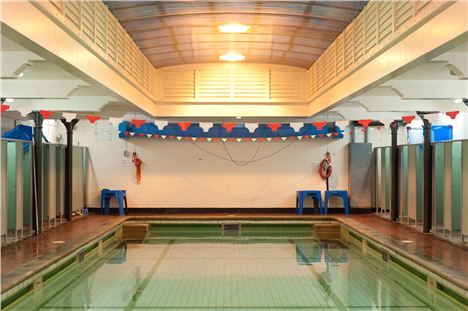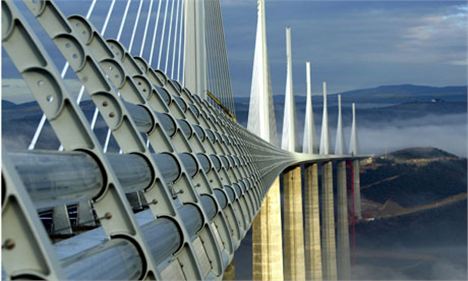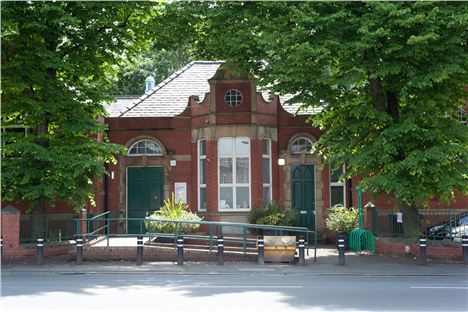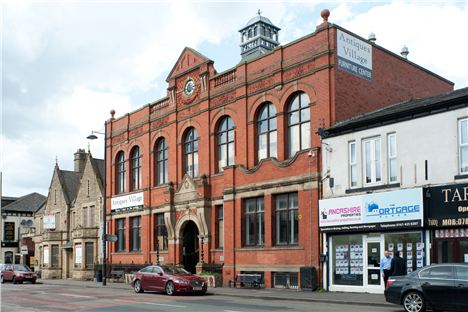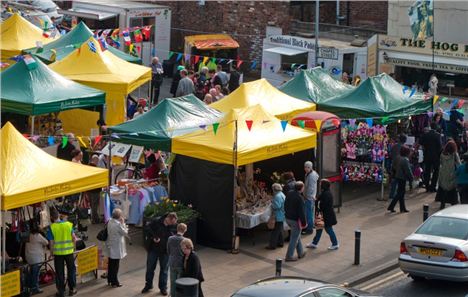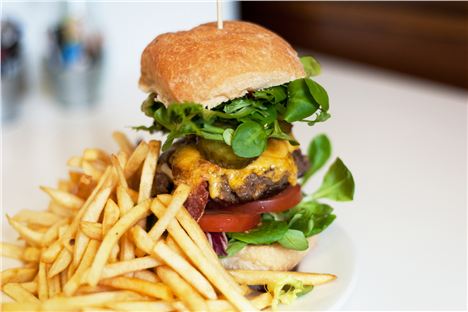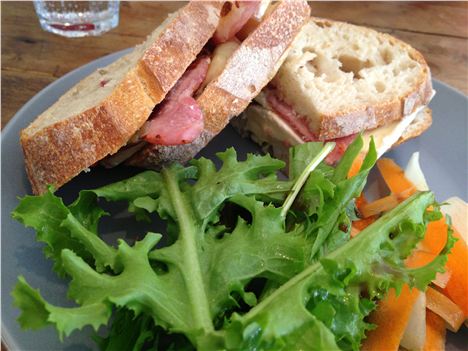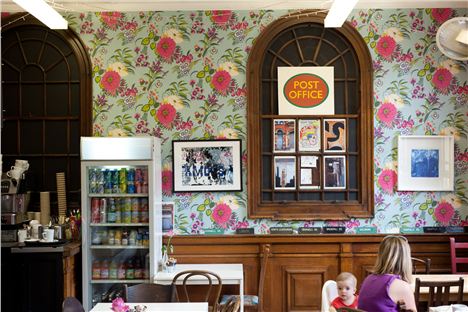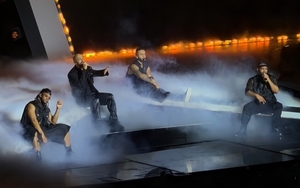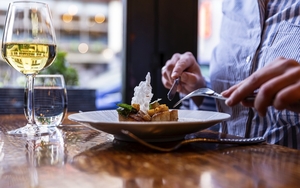I LIVED at 3 Westminster Street, close to Levenshulme baths, until I was nine. Then we moved to the other side of Stockport Road. I could tell you about mum and dad, Tittertons pork pies and beef dripping, Platt’s furniture shop, Sivori’s ice cream, Saturday matinees at the Palace, and all that David Copperfield crap.
She is from Bangladesh, and she’s lived on Westminster Street thirteen years, as long as we Griffins did. “We love it, it’s a nice place to live."
Right now though, there’s the West London College of Business and Management Sciences, Manchester Campus, whose main building used to be a greengrocers shop. A shop with no windows that opened right on to the pavement, on the corner of Stockport Road and Carrill Grove.
At the back of the greengrocers, on either side of a door, were open skips for spuds, chippers or mashers, fed from hoppers above. The greengrocer topped them up with sacks he carried in from the back, balanced over his shoulder, forcing his head to one side. His hair was sandy. He wore tan coloured overalls and a sleeveless brown leather jerkin. He was the dusty, rich golden clay-colour of a Cyprus potato, and he is the very first thing in my life I remember. Him, as he leant in to look at me, sprawled in my Silver Cross pram.
Once there was a greengrocers
The greengrocers is part of a private college now, with windows and a big sign with a crest. I think they specialise in citizenship, English language and training for work in care homes. Across the road is an Asian greengrocer who piles his mangoes and melons, ginger root, okra and eggplant out on the street.
Levenshulme, the suburb with the rich Viking name, and a certain Victorian status, brought on when the railway came through, is an Empire contained in a postcode. M19, from Matthews Lane south to the Broom Lane junction, is a fine Edwardian High Street, if not in tact, then far from destroyed.
Redemption, rehabilitation, regeneration, whichever process you care to identify, work has been done, across a couple of decades, that helped arrest urban decline, and has turned in to something positive. Whether it’s nights in the Klondyke, Blue Bell or Fiddler’s Green, Union, M19 or Hennigan’s, or days in Levy Market, Pod deli, Isis (which might have to think of a name change), Antiques Village, or Trove, Levenshulme rolls its own way, and emphatically isn’t Chorlton, West Didsbury or Fallowfield.
Levenshulme in action
I’ve always thought Levenshulme over-stuffed with churches. They seemed to shoulder their way on to the road, and are now largely unwanted. St Peter’s has the tallest tower, and has been touched by the hand of Laurence Llewelyn-Bowen.
Given the lilt of County Levenshulme, it’s surprising that St Mary of the Angels and St Clare doesn’t have a bigger presence. Clare Road is named for the Poor Clare’s nunnery that the original church and school were built alongside. They both got too small and, in 1957 following the first reported death of cinema by TV, St Mary moved in to The Grand picture palace.
St Mary of the Angels
This was weird. The church had a raked floor and pews where the plush seats had been. The new church, with its Lantern Tower and Technicolour panorama window opened in 1975. At which point The Grand became a piano graveyard, and the church was tucked away. The entrance is on Elbow Street, which is the only case I know of a band getting a street named after them before their grandparents were born. Incidentally, the memorial street is a designated Play Street, closed to through traffic during daylight hours. Seldom Seen Kid.
Drinking in the morning sun, Blinking in the morning sun, Shaking off a heavy one...in Levenshulme
Elbow Street leads to Chapel Street that still has car repair workshops and the empty and crumbling Atlas Engineering Works. There was another engineers, on the corner of Elbow Street. I walked to school this way, and if it is possible to remember a smell, it is of sump oil and oxy acetylene torches. If the big chain roller-shutter was open in summer I could peer through the dark and see the man in the iron mask flaying sun-hot sparks with his piercing blue flame. Gone. So’s the Chapel Street dole office that shadowed the decline in local industry.
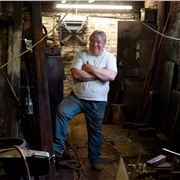 Barry going strongNot gone, Barry Dean’s Smithy, up an entry, back of Cromwell Grove. Barry’s dad was a smithy before him, up by the Midway. A farrier too, shoeing the horses for Longsight police station.
Barry going strongNot gone, Barry Dean’s Smithy, up an entry, back of Cromwell Grove. Barry’s dad was a smithy before him, up by the Midway. A farrier too, shoeing the horses for Longsight police station.
Barry does gates and fancy fences now. We both went to St Mary’s. He’s kept in touch with far-flung classmates. One has a vineyard in California. Three of them are getting together next year, and heading to Vegas for a joint 65th.
Barry made gates for my mum.
Forging ahead
Up Cromwell Grove to sad corner, the junction with Barlow Road. Two buildings in peril, the Library and Baths. Battles lost and won don’t need fighting again here. Plans for a new building, incorporating library, two pools, sauna and steam room, gym and dance studios are on public display at the Inspire centre until 26 June. The proposed site is the old Arcadia (another ancient cinema), fronting on to Stockport Road. It looks to me like a companion piece to Longsight Library (by Walker Simpson Architects). This design is by Aedas and I think it looks fine.
The doomed baths
The Arcadia backs on to Crescent Grove. If Manchester has one success story, one rags-to-riches tale on the scale of the American Dream, bigger than Wayne Fontana, it began here, at 4 Crescent Grove, in June 1935, when Robert and Lillian Foster moved in with Norman, their weeks-old son. He stayed here for twenty-six years.
 Norman FosterIn 1999 Norman was introduced in to the House of Lords as Baron Foster of Thames Bank, a title he’s surrendered since moving to homes in Switzerland and the South of France. Norman Foster is the most successful British architect of all time.
Norman FosterIn 1999 Norman was introduced in to the House of Lords as Baron Foster of Thames Bank, a title he’s surrendered since moving to homes in Switzerland and the South of France. Norman Foster is the most successful British architect of all time.
He’s designed at least a dozen of the most notable buildings of the last forty years, including the Reichstag in Berlin, Hong Kong and Shanghai Bank, Millau Viaduct, Stanstead Airport and 30 St Mary Axe, also known as the Gherkin. Foster + Partners is the biggest architectural practice in the UK, and the most admired practice in the whole of the profession. Foster took an interest in Levenshulme Library.
The Millau Viaduct - the Levy Lad's done well
He was in competition to refurbish the New York Public Library. He sent people from his London office to photograph the library where, as a kid, he first came across the work of Frank Lloyd Wright, Louis Sullivan and Le Corbusier. He won the competition, and Levenshulme, whilst not having lost its library, has it closed more than open, and stripped of a lot of its stock.
Norman's old house
It’s a Carnegie Library, meaning it is one built with money donated by the Scottish-American steel magnate Andrew Carnegie. Perhaps it was his conscience salving habit. He funded 2,500 of them, 660 in Britain. Didsbury has one too. And you can’t just get rid of them. Levenshulme High School has offered to put money and teaching hours into the building, and to co-run it as a community library.
The library and another uncertain future
Allegedly the Baths costs too much to keep open, which hurts generations of people whose time with polystyrene floats and heavy rubber bricks that smelt uncannily of Cadbury’s chocolate, is fondly remembered. Levenshulme High School girl Sunny Lowry trained here. In 1933, she was the first British woman to swim the channel. Her father was a fishmonger. The building straddles its curving site with some style. Facing the library, they make a handsome pair.
Levenshulme has a few such handsome buildings. It was an autonomous township before joining Manchester in 1909, and punched somewhat above its weight. Hence the fine Council Offices, and the rather bizarre rusticated lean-too which, for the last thirty years, have constituted the Antiques Village. They’ve lately discovered G-Plan and Ercol, and the heavy brown furniture and acid-dipped Victoriana is beginning to surrender space to the current taste for the 1950s and beyond. There’s a working (in so far as they ever did) Sinclair C5 sitting on top of a mahogany table in a downstairs front room at the moment. Make way for early Macs and Nokia mobiles.
From administration to antiques
Levenshulme Market, now weekly on the car park by the station (with its Gaelic sign), is a clear pointer to Levenshulme’s modern identity, with organic this and crafted that, and the rich perfume of Burmese cooking and gourmet bangers, like the entire length and breadth of the A6, reeled in and laid out on trestle tables.
Levenshulme food market
Pod deli for lunch. “Do you want to photograph the burger before we serve it?” we are proudly asked by chef. It looks terrific. “And it’s the best you’ll get anywhere,” confirms the happy eater, wiping his Levy beard. He and his girlfriend live three doors down from Lord Foster’s first home. They teach at his university. “Typical new Levenshulme,” they chip.
Pod grub
And Trove.
The first time I step into the micro bakery-café opposite the Town Hall, I’m behind Peter O’Grady, fellow of my primary school, our parents lived on the same street. Peter was maître d’ and co-proprietor of legendary Northern Quarter restaurant (before they sold it) The Market. I look at the shelves of bread, “Which do you recommend?” “All of them. They are all fantastic.” He fills his bag with a baker’s dozen golden, fragrant treasures. I have breakfast. Two soft poached eggs and dry cured bacon on lightly toasted sourdough, and coffee. Never better.
Lovely grub at Trove
Mog lives on Cromwell Grove, presents the Saturday morning shift on All FM and plays bass in the Lonesome and Penniless Cowboys, second and fourth Thursdays at the Klondike. Tony Trundle, fiddle player, flies in from Galway on the last Thursday of the month. If you haven’t seen their Cash-Williams-George Jones mash-up over any of the three decades they’ve been refining it, catch it whilst they’re still standing, so to speak.
Levenshulme Food & Drink Festival kicks off in the Market, Hennigan’s and the Union at 3pm on Friday 20 June, for a week. We sold our mum’s house a month ago, to pay for her care home, which is just round the corner from West Point. We take her to Pod when the weather’s fine, though her Alzheimer’s doesn’t really allow her to connect to the Post Office she’d known for seventy years.
Pod Deli in the old Post Office
What might she make of new Levenshulme, the fast food, unfamiliar fruit and veg and foreign-sounding people? I went to look at 3 Westminster Street the other day. A woman came out from No 1. She was with her two daughters, not yet teenagers. She wore a red top and they were piling into a red Renault. She is from Bangladesh, and she’s lived on Westminster Street thirteen years, as long as we Griffins did. “We love it, it’s a nice place to live."
Mr Griffin goes home
My friend the writer Tom Malloy, sage of Simonsway, describes Levenshulme as, “gritty”. Is that the grit that gets in your eyes, or the grit that makes the pearl? Other Levenshulme friends tell me good and bad bits, bits of dissimilar geographical identity. Nawaab, the Asian Banqueting suites that used to be the Regal cinema, and Bowling Alley and Bingo Hall, looks like it’s barricaded for a mortar attack during the day.
The Nawaab is very Regal
Timber and Tools marks the north of the hood, and Gay Lyfe Tropical Fish & Accessories still has me guessing. Rushford Park Conservation Area off Slade Lane hints at life before the railway. Wandering up Barlow Road towards the bit of East Levenshulme improbably called Talleyrand, remembering the clay pits, brick works, UCP tripe factory and Robinsons bakery, tells me how it went. Trove and Pod, Klondike and the market on Saturday tell me how it goes.
Grit in the eye, or grit in the oyster? Grit that makes the pearl, I’d say.
The Manchester Beat Part Five: Alderley Edge
The Manchester Beat Part Four: Wythenshawe
The Manchester Beat Part Three: Cheadle
The Manchester Beat Part Two: Prestwich
The Manchester Beat Part One: West Didsbury
You can follow Phil Griffin on Twitter here.
Thanks to Jan Chlebik for the pictures (except Trove, Levenshulme Market, Millau Viaduct and Norman Foster portrait).








